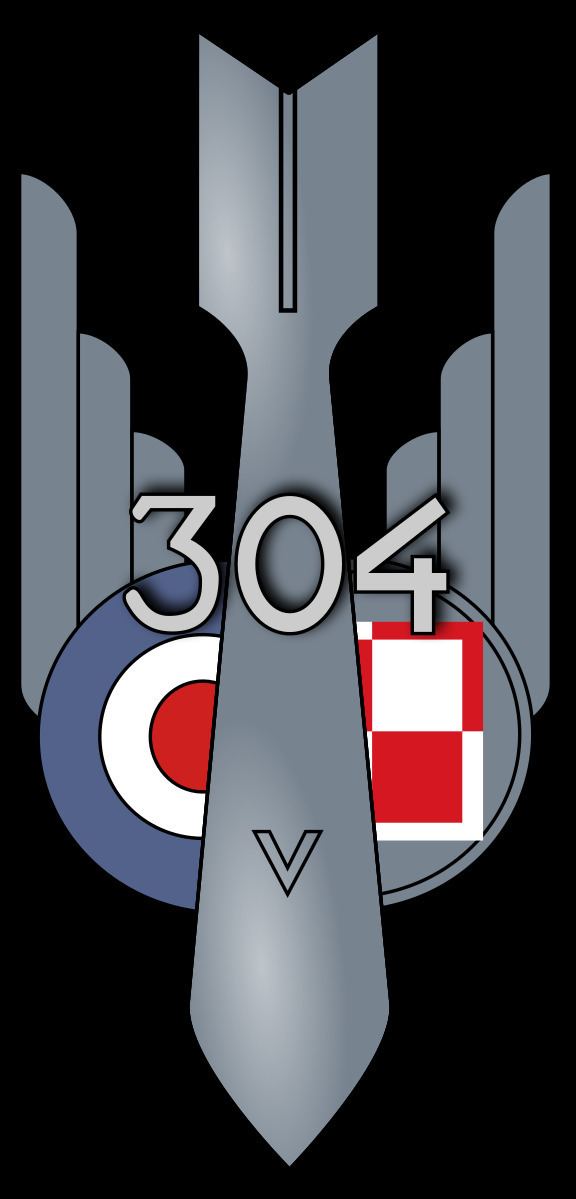 | ||
Active 22 August 1940 – 18 December 1946 Role Bomber SquadronAnti-Submarine SquadronTransport Squadron Part of RAF Bomber CommandRAF Coastal CommandRAF Transport Command | ||
No. 304 (Land of Silesia) Polish Bomber Squadron (Polish: 304 Dywizjon Bombowy "Ziemi Śląskiej im. Ks. Józefa Poniatowskiego") was a Polish World War II bomber unit. It fought alongside the Royal Air Force under their operational Command and operated from airbases in the United Kingdom, serving from April 1941 as a bomber unit in RAF Bomber Command, from May 1942 as an anti-submarine unit in RAF Coastal Command and from June 1945 as a transport unit in RAF Transport Command.
Contents
Bomber Command
304 Squadron was created on 23 August 1940 at RAF Bramcote, and from 1 December 1940 it operated from RAF Syerston, as a part of No. 1 Bomber Group (along with No. 305 Squadron created at the same time). It was declared ready for operations with Vickers Wellington Mk I medium bombers on 24 April 1941. The personnel included 24 entirely Polish air crews (initially three-men, later six-men) and approximately 180 of ground crew. At night 24/25 April 1941 two crews flew the first combat mission against fuel tanks in Rotterdam. In the following months the squadron joined in a night bombing campaign over Germany and France. First losses occurred on 6 May and 8 May 1941 (in the second instance, a crew of the British advisor w/cdr W. Graham). On 20 July 1941 the squadron moved to RAF Lindholme base. In 1941 the squadron completed 214 missions lasting 1,202 hours, losing 47 killed airmen.
In first four months of 1942 an intensity of actions raised. Due to big losses suffered in early 1942, including six crews lost in April, and a difficulty to get replacements, it was decided to transfer the squadron to RAF Coastal Command. In Bomber Command the squadron completed 488 missions in 2,481 hours, dropping some 800 tons of bombs, losing 102 airmen KIA or MIA and 35 POW.
Coastal Command
On 10 May 1942 it was transferred to RAF Coastal Command along with the Wellingtons. From 14 May 1942 it based at RAF Tiree, from 13 June 1942 at RAF Dale. Apart from patrolling duties over Biscayne Bay, seven crews took part in a thousand-aircraft raid at Bremen on 25/26 June 1942 (losing one crew). Several times Polish crews attacked U-boats and fought with German long-range aircraft. A noteworthy event was a skirmish of one Wellington with six German Junkers Ju 88 on 16 September 1942 over Biscayne Bay; The Polish aircraft was badly shot, but managed to hide in clouds, and claimed one Ju 88 shot down. On 9 February 1943 one Wellington fought against four Ju 88 for nearly an hour, with two Polish crewmen injured; similar combat with four Ju 88 took place on 5 September 1943, without losses. From 30 March 1943 the squadron based at RAF Docking, from 10 June 1943 at RAF Davidstow Moor (equipped with radar-fitted Wellington Mk XIII), from 20 December 1943 at RAF Predannack, from 19 March 1944 at RAF Chivenor. On 4 January 1944 a Wellington strafed and damaged German submarine U-629. On 18 June 1944 the squadron was credited with sinking a U-boat, quoted to be U-441 (it is disputed in new publications, though). From 19 September 1944 it was based at RAF Benbecula, from 5 March 1944 at RAF St Eval.
In Coastal Command the squadron undertook 2,451 missions in 21,331 hours, losing 19 aircraft and 69 KIA, 6 MIA and 31 killed in non-combat flights. It claimed 31 submarine attacked and was credited with two U-boats sunk and five damaged, it also claimed three aircraft shoot down, three probable and four damaged.
Its last mission was on 30 May 1945, looking out for possible German submarines that would not surrender.
Transport Command
After the end of the war in Europe, on 14 June 1945 it was transferred to Transport Command, operating scheduled services with Warwick C.3s to Greece and Italy, but after April 1946 the Polish squadrons were restricted to flights within the UK. In May the squadron converted to Halifax Mk C.8 unarmed transports and was disbanded a few months later on 18 December 1946.
No. 304 Squadron plane sunk German submarine U-321.
Squadron bases
The squadron operated from the following airfields:
Commanding officers
Officers commanding No. 304 Squadron were as follows:
Ppłk. - podpułkownik - equivalent w/cdr; Mjr. - major - equivalent s/ldr; Kpt. - kapitan - equivalent f/lt
